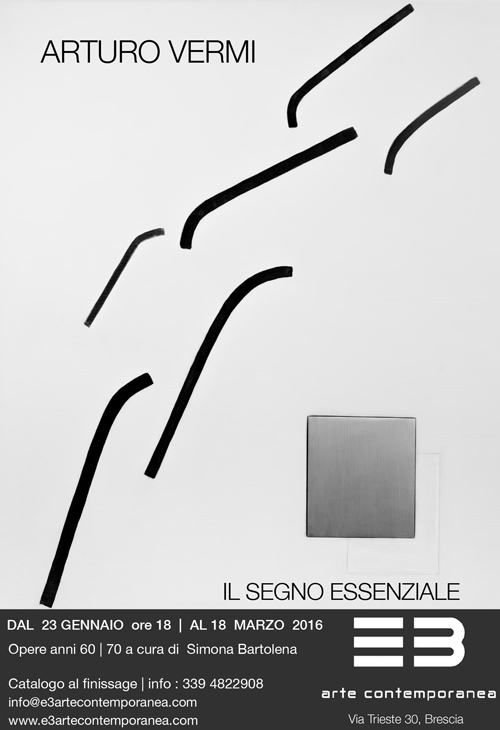Arturo Vermi
IL SEGNO ESSENZIALE
January -march 2016
A Poetic Flight
Milan 1962. During a fertile and dynamic season in Milan, one of the main centers of European culture, a group of artists begins to give deep thought to painting and its expressive-scriptural value. Agostino Ferrari, Ugo La Pietra, Ettore Sordini, Angelo Verga and Arturo Vermi are the members of this association: The Cenobio Group. It is a union that is short lived but very intense. Based on the decision to stay away from market values and influences, these artists weave a story together while looking for the answer to arte segnica, “an art in marks”, deeply evocative, almost a secret language, in line with, although on a different track to, the avant-garde trends of the time that were generated on the streets of the Brera district, in phenomena such as Azimuth or the art of Gruppo T.
This is the Milan of the Jamaica Bar, of Lucio Fontana, Piero Manzoni and of the large galleries from Naviglio to Milione, from Gianferrari to Bergamini, from the Annunciata to Schettini. A city in which Vermi, originally from Bergamo, moves to in 1956, and where he immediately becomes part of the Brera scene. As a self-taught painter he initially chooses, as do many of his generation, to use the most widely used language of the time: the informal. To complete his humanistic and artistic training though he travels to and lives in Paris for a few years from 1959, spending time with artists such André Bloc and Ossip Zadkine and where he meets Beniamino Joppolo, already a founder along with Lucio Fontana of the Spatialist Movement. Upon his return to Milan, where he becomes a mover and organizer for the Cerobio Group, Vermi is already an artist with a strong and original personality. During these years he works with an informal matrix technique that is characterized by large geometric fields of color, painted in colours such as brown and dark green, and deep red and black -, but this is also the period of the first “Lapidi” and consequently the first “Diari”. In the following years, while spending time with Lucio Fontana and other artists from the Botteghe di Sesto San Giovanni quarter, where Vermi lives also from 1964, the turning point is definitive. Informalism is abbandoned and Vermi finds his hallmark: a distinctive hallmark and one that is extraordinarily effective, one in which lies the essence of his quest. First of all there is his fabulous capacity to synthesize: a perfect sythesis that at the same time demonstrates his knowledge. He demonstrates the essentials, reduced into one single mark in which the collective memory is hidden. These are places in which the universal dimension meets the private, real life – the physical substance that Vermi never loses sight of – the opening of light and what we find eternal in gold. These are the marks that we see repeated and obsessed over by Vermi in the “Diari” collection and also seen in single works such as Presenze e delle Marinewhich are very exact. In Paesaggithese marks are much more dynamic and rapid. It’s amazing to see the perfection with which the artist chooses the location to place the presence of marks; in perfect balance in a way that the compostition always has a logic and harmony.
And then there is timing. Time delineated by a line, a mark: a time not always regular but inexorable. There is the rhythm of time, a slow meditation sometimes or the rapid, short movements of everyday life. He seems to hear their sound, a clicking sound lost in the silence of the cosmos and the clinking of the glasses in a tavern in Brera.
Every stroke made by Vermi is generated by this extraordinary ability to remain light of heart, of flying and knowing how to be happy. Happiness is never selfish, but conversely, feeling happiness around others spreads this feeling and is contagious, teaching them to soar over all contingencies. Perhaps Vermi’s work is just that: a poetic flight.
Simona Bartolena


